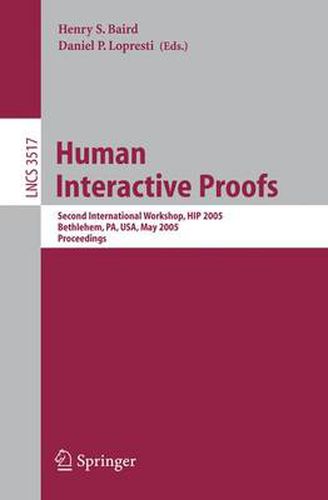Readings Newsletter
Become a Readings Member to make your shopping experience even easier.
Sign in or sign up for free!
You’re not far away from qualifying for FREE standard shipping within Australia
You’ve qualified for FREE standard shipping within Australia
The cart is loading…






This title is printed to order. This book may have been self-published. If so, we cannot guarantee the quality of the content. In the main most books will have gone through the editing process however some may not. We therefore suggest that you be aware of this before ordering this book. If in doubt check either the author or publisher’s details as we are unable to accept any returns unless they are faulty. Please contact us if you have any questions.
E-commerce services are su?ering abuse by programs (bots, spiders, etc.) m- querading as legitimate human users. E?orts to defend against such attacks have, over the past several years, stimulated investigations into a new family of security protocols - Human Interactive Proofs (HIPs) - which allow a person to authenticate herself as a member of a given group: e.g., as a human (vs. a machine), as herself (vs. anyoneelse), as an adult (vs. a child). Most commercial usesofHIPstodayareCAPTCHAs, CompletelyAutomaticPublicTuringtests to tell Computers and Humans Apart, which exploit the gap in ability between humans and machine vision systems in reading images of text. HIP challenges can also be non-graphical, e.g., requiring recognition of speech, solving puzzles, etc. Wearepleasedtopresentthe?rstrefereedandarchivallypublishedcollection of state-of-the-art papers on HIPs and CAPTCHAs. Each paper was reviewed by three members of the Program Committee, judged by the Co-chairs to be of su?cient relevance and quality, and revised by the authors in response to the referees’ suggestions. The papers investigate performance analysis of novel CAPTCHAs, HIP - chitectures, and the role of HIPs within security systems. Kumar Chellapilla, Kevin Larson, Patrice Simard, and Mary Czerwinski describe user trials of a CAPTCHA designed to resist segmentation attacks, including a systematic evaluation of its tolerance by human users. Henry Baird, Michael Moll, and Sui- Yu Wang analyze data from a human legibility trial of another segmentati- resistantCAPTCHAandlocateahighlylegibleengineeringregime.AmaliaRusu and Venu Govindaraju describe research towards CAPTCHAs based on reading synthetically damaged images of real images of unconstrained handwritten text.
$9.00 standard shipping within Australia
FREE standard shipping within Australia for orders over $100.00
Express & International shipping calculated at checkout
This title is printed to order. This book may have been self-published. If so, we cannot guarantee the quality of the content. In the main most books will have gone through the editing process however some may not. We therefore suggest that you be aware of this before ordering this book. If in doubt check either the author or publisher’s details as we are unable to accept any returns unless they are faulty. Please contact us if you have any questions.
E-commerce services are su?ering abuse by programs (bots, spiders, etc.) m- querading as legitimate human users. E?orts to defend against such attacks have, over the past several years, stimulated investigations into a new family of security protocols - Human Interactive Proofs (HIPs) - which allow a person to authenticate herself as a member of a given group: e.g., as a human (vs. a machine), as herself (vs. anyoneelse), as an adult (vs. a child). Most commercial usesofHIPstodayareCAPTCHAs, CompletelyAutomaticPublicTuringtests to tell Computers and Humans Apart, which exploit the gap in ability between humans and machine vision systems in reading images of text. HIP challenges can also be non-graphical, e.g., requiring recognition of speech, solving puzzles, etc. Wearepleasedtopresentthe?rstrefereedandarchivallypublishedcollection of state-of-the-art papers on HIPs and CAPTCHAs. Each paper was reviewed by three members of the Program Committee, judged by the Co-chairs to be of su?cient relevance and quality, and revised by the authors in response to the referees’ suggestions. The papers investigate performance analysis of novel CAPTCHAs, HIP - chitectures, and the role of HIPs within security systems. Kumar Chellapilla, Kevin Larson, Patrice Simard, and Mary Czerwinski describe user trials of a CAPTCHA designed to resist segmentation attacks, including a systematic evaluation of its tolerance by human users. Henry Baird, Michael Moll, and Sui- Yu Wang analyze data from a human legibility trial of another segmentati- resistantCAPTCHAandlocateahighlylegibleengineeringregime.AmaliaRusu and Venu Govindaraju describe research towards CAPTCHAs based on reading synthetically damaged images of real images of unconstrained handwritten text.